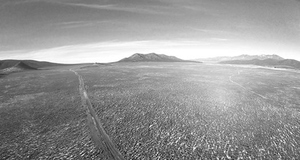From Earth Common Journal VOL. 5 NO. 1Fire for Well-Being: Use of Prescribed Burning in the Northern Boreal ForestConservation of Medicinal PlantsMedicinal plants and their acquired knowledge is sacred to the Aboriginal peoples of the boreal forest. People gain medicinal knowledge from Elders; however, it may take an entire lifetime, as it is not "the type of knowledge that can be handed down in one afternoon" (Belcourt, 2007, p. 4). As such, plant resources and the knowledge to use them are managed by Aboriginal peoples with their own conservation methods. As Aboriginal peoples developed a symbiotic relationship with plant and animals species in their environment, they developed conservation practices based on respect. The first step in conservation is to pass along the knowledge to future generations, to ensure it is never lost. Elder Ella Green recalls her aunties taking her into the bush to teach her about the different kinds of plants and their medicinal uses (Berkes, 2012, p. 112). In addition to conservation of knowledge, plants are only collected in a manner that ensures their continued productivity (Uprety, Asselin, Dhakal, & Julien, 2012, p. 7). Prescribed burning ensures this optimum level of plant species. But only one-tenth of medicinal plants were picked (Belcourt, 2007, p. 10). Sites were never picked clean. As a form of respect, Aboriginal peoples took only what they needed without excess. This assured that enough was left to propagate for future availability. Aboriginal peoples always thanked the plant's spirit, as the plant gave its life to prolong the lives of others (p. 5). To show one's respect, when a plant is taken, an item is always offered in return, such as tobacco. All parts of the plant are used, nothing is wasted. The plant parts are used to prepare a variety of remedies to treat illnesses. The roots, rhizomes, stem, bark, leaves, flowers, fruits, young shoots, and whole plants were used to make poultices, powders, teas, and pastes (Uprety, Asselin, Dhakal, & Julien, 2012, p. 5-6). Aboriginal peoples develop practices in sync with their landscape to ensure continuous abundance of plants. Aboriginal peoples' burning practices and respect for the environment ensures their improved and future well-being in the boreal forest. Future ConservationConservation of medicinal plants and berry patches is a concern for Aboriginal peoples. Increasingly, traditional berry patches are lost due to the drying and clearing of land associated with development (Parlee, Geertsema, & Willier, 2012, p. 7). The biggest threat to medicinal plants is the loss of habitation, specifically from human development (Uprety, Asselin, Dhakal, & Julien, 2012, p. 7). As the entire ecosystem is based on inter-related relationships, destruction of berry patches may also result in devastating effects for the birds and bears that rely on them for food. Plant and animal habitats are increasingly becoming threatened by clearcut logging, strip mining, and large-scale agriculture (Kuhnlein & Turner, 1991, p. 21). Mining for resources, especially the oil development in the north, has left many fearing the ecosystem is no longer healthy. Conservation approaches have focused less on the importance of medicinal plant resources. Furthermore, ethnobotanical studies on medicinal plants are scarce. Uprety, Asselin, Dhakal, and Julien (2012) attribute such little study in the area due to Aboriginal peoples' reluctance to share their knowledge (p.7). Aboriginal peoples' concerns derive from fear that profit-seeking pharmaceutical companies – without acknowledging or involving communities – will take their knowledge (p. 7). Elder Richardson, expresses her concerns, stating that "information is taken from our people and it becomes patented and copyrighted…as industry moves further north we are beginning to lose control of land on which our medicines grow" (Belcourt, 2007, p. 4). Concern grows that with fewer Aboriginal peoples living full-time in the bush, medicinal knowledge will be completely lost. Elder Richardson further explains that: "…land has to be set aside to preserve these medicines, and to allow them to grow in their natural environment. We are people of the land. We must remain protectors of the land" (Belcourt, 2007, p.10). More research and attention should be allocated to conservation efforts of medicinal plants and other plant resource destruction in the boreal forest. Conservation methods must acknowledge and partner with local Aboriginal groups to work towards monitoring and managing the land. ConclusionThe health and well-being of Aboriginal peoples in the northern boreal forest relies on the health and well-being of the forest and all species within it. For many Aboriginal peoples, maintaining health means "living in harmony with our natural surroundings and understanding our existence as a relational part to the rest of our mother earth. In taking care of our earth, we are taking care of ourselves" (Settee, 2011, p. 28). Aboriginal peoples in the boreal forest modified their environment with the proven method of prescribed burning. Prescribed burning is necessary for hunting and gathering resources, using medicinal plants, supporting berry bush growth, and riding the area of pests. Women engaged in habitat management of these plants in order to curb health crises. Aboriginal women retain a central role as community organizers, planners and leaders (p. V). As such, Aboriginal women's activities correspond to their important role of maintaining their family and community health by upholding traditional medicinal plants, berry patches and overall comfort. Women learn medicinal knowledge from the generation before them. The diverse use of fire reveals the importance of maintaining a comfortable, healthy life in the boreal forest. By the early twentieth century, legislation and regulations curbed Aboriginal prescribed burning practices. These remain in place today, requiring Aboriginal communities to apply for permits prior to practicing traditional burning. As per Alberta Environment and Sustainable Resource Development First Nation communities require fire permits and must plan a prescribed fire with their local prevention officer (ESRD Website, 2013). As per Section 20 of the Forest and Prairie Protection Act, a permit granted may just as quickly be cancelled. A fire started without a permit is punishable by fines. Although government is attempting to coordinate efforts, Aboriginal communities continue to pursue government to recognize their prescribed burning practices. While fewer Aboriginal people live in the bush, efforts are being made, especially by community Elders, to strengthen their traditional knowledge for future generations. AuthorChantal Roy Denis completed the Bachelor of Arts program at MacEwan University in 2015. A Métis women originally from St. Louis-Batoche, Saskatchewan with deep rooted passion and respect for Aboriginal histories and traditions. She is attending Graduate Studies at the University of Alberta in Fall 2015. ReferencesAlberta Environment and Sustainable Resource Development. (2013). Prescribed Burning. Retrieved from http://www.wildfire.alberta.ca/prescribed-fires/default.aspx. Belcourt, C. (2007). Medicines to help us: Traditional Métis plant use. Saskatoon: Gabriel Dumont Institute Berkes, F. (2012) Sacred ecology. Third Edition. New York: Routledge. Berkes, F., & Davidson-Hunt, I. J. (2006). Biodiversity, traditional management systems, and cultural landscapes: examples from the boreal forest of Canada. International Social Science Journal, 58 (187), 35-47. Boag, F. (2015, February 26). Anthropology 399: Ecological Perspectives, Class Lecture. MacEwan University. Boag, F. (2015, March 7). Anthropology 399: Ecological Perspectives, Class Lecture. MacEwan University. Derworiz, C. (2015, January 27). Fire crews get head start on season with prescribed burn. Calgary Herald. Retrieved from http://calgaryherald.com/news/local-news/fire-crews-get-head-start-on-season-with-prescribed-burn. Garvin, T. (1992). Bush land people. Calgary: Arctic Institute of North America of the University of Calgary. Kuhnlein, H.V., & Turner, N.J. (1991). Traditional plant foods of Canadian indigenous peoples: Nutrition, botany, and use. Food and Nutrition in History and Anthropology Volume 8. Philadelphia: Gordon and Breach. Lewis, H.T., & Ferguson, T.A. (1998). Yards, corridors, and mosaics: How to burn a boreal forest. Human Ecology, 16 (1), 57-77. Lewis, H.T. (1982). A time for burning. Edmonton: Boreal Institute for Northern Studies, University of Alberta. McAdoo, K., Schultz, B.W., & Swanson, S.R. (2013). Aboriginal precedent for active management of sagebrush-perennial grass communities in the great basin. Rangeland Ecology & Management, 66 (3), 241-253. Meili, D. (1991) Those who know: Profiles of Alberta's native elders. Edmonton: NeWest Press. Miller, A.M., & Davidson-Hunt, I.J. (2010). Fire, agency and scale in the creation of aboriginal cultural landscapes. Human Ecology, 38 (3), 401-414. Nelson, M., Natcher, D.C., & Hickey, C.G. (2005). Social and economic barriers to subsistence harvesting in a northern Alberta aboriginal community. Anthropologica, 47 (2), 289-301. Parlee, B.L., Geertsema, K., & Willier, A. (2012). Social-ecological thresholds in a changing boreal landscape: Insights from Cree knowledge of the lesser Slave Lake region of Alberta, Canada. Ecology & Society, 17 (2), 1-13. Settee, P. (2011). The strength of women: Âhkamêyimowak. Regina: Coteau Books. Turner, N. J., Davidson-Hunt, I.J., & O'Flaherty, M. (2003). Living on the edge: Ecological and cultural edges as sources of diversity for social-ecological resilience. Human Ecology, 31 (3), 439-461. Uprety, Y., Asselin, H., Dhakal, A., & Julien, N. (2012). Traditional use of medicinal plants in the boreal forest of Canada: review and perspectives. Journal of Ethnobiology and Ethnomedicine, 8 (7), 1-14. Suggested Reading from Inquiries Journal
Inquiries Journal provides undergraduate and graduate students around the world a platform for the wide dissemination of academic work over a range of core disciplines. Representing the work of students from hundreds of institutions around the globe, Inquiries Journal's large database of academic articles is completely free. Learn more | Blog | Submit Latest in Environmental Studies |



















